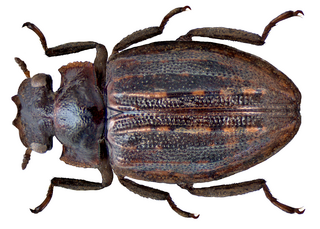
Spercheus is a genus of aquatic beetles which are placed in a family of their own, Spercheidae within the Hydrophiloidea. About 20 species are known from around the world except the Nearctic with the majority being from the Oriental and Afrotropical Realms.

Hydrophilidae, also known colloquially as water scavenger beetles, is a family of beetles. Aquatic hydrophilids are notable for their long maxillary palps, which are longer than their antennae. Several of the former subfamilies of Hydrophilidae have recently been removed and elevated to family rank; Epimetopidae, Georissidae, Helophoridae, Hydrochidae, and Spercheidae. While the majority of hydrophilids are aquatic, around a third of described species are terrestrial, mostly belonging to the subfamily Sphaeridiinae.

Berosus is a genus of beetles in the family Hydrophilidae, the water scavenger beetles. The genus contains 273 species. It is distributed worldwide.
Berosus aculeatus is a species of hydrophilid beetle native to the United States and Cuba. It was originally described by John Lawrence LeConte in 1855 and is characterized by prolonged apices of its elytra.
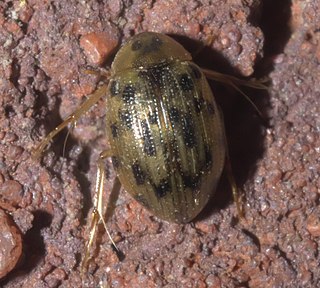
Berosus pantherinus is a species of hydrophilid beetle native to the United States. It was originally described by John Lawrence LeConte in 1855 and is characterized by having ten dark spots on each elytron.
Berosus pugnax is a species of hydrophilid beetles native to the United States. It was originally described by John Lawrence LeConte in 1863 and is characterized by having emarginate apices on its elytra.
Berosus ordinatus is a species of hydrophilid beetles native to the United States, specifically in the states of Maryland, Delaware, New York, New Jersey, Pennsylvania, Connecticut, and Rhode Island. It was originally described by John Lawrence LeConte in 1855 and is characterized by slightly divergent and prolonged elytral apices.
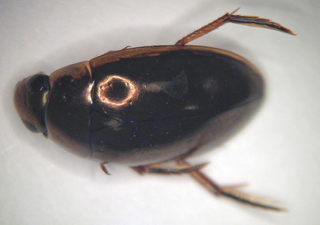
Tropisternus lateralis is a species of hydrophilid beetle that ranges across much of the Americas.

Helochares is a genus of water scavenger beetles in the family Hydrophilidae, represented by 161 described species. It is distributed across the Afrotropical, Australasian, Indo-Malayan, Nearctic, and Palearctic realms.

Helobata is a mostly Neotropical genus of water scavenger beetle in the family Hydrophilidae. It contains 13 described species, one of which is broadly distributed, reaching North America.
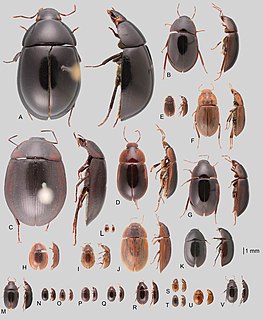
Acidocerinae is a subfamily in the family Hydrophilidae of aquatic beetles, and it contains over 500 species in 23 genera.

Paracymus is a genus of hydrophilid beetles with 81 species worldwide.

Berosus sayi is a species of hydrophilid beetles native to the United States. It is a synonym of Berosus striatus, which was originally described by Thomas Say in 1825, and females can be characterized by a small tooth on the suture near the apex of each elytron.

Hydrophilus triangularis, known generally as the giant black water beetle or giant water scavenger, is a species of water scavenger beetle in the family Hydrophilidae. It is the most common and widespread species of Hydrophilus in North America, being found across the contiguous United States, southern Canada, and Mexico.

Hydrophilus ovatus is a species of water scavenger beetle in the family Hydrophilidae. It is found in the eastern United States from Maine south to Florida and west to Texas and Kansas, southern Ontario and Quebec, and south to southern Mexico.

Hydrophilus insularis is a species of water scavenger beetle in the family Hydrophilidae. It is found from northern South America north throughout the Caribbean, Central America, and Mexico into southern Arizona, California, Texas, and Florida in the United States.
Hydrophilus ensifer is a species of water scavenger beetle in the family Hydrophilidae found in the Americas. As of 2020, there are two valid subspecies of H. ensifer, H. e. ensifer and H. e. duvali, however the differences among the subspecies are not well understood.
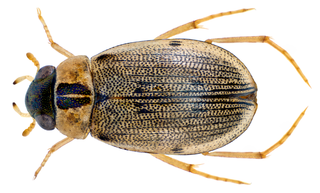
Berosus pulchellus, is a species of water scavenger beetle found in Oriental, Australasian, Afrotropical and Palaearctic regional countries such as India, Sri Lanka, Hong Kong, Japan, Iran, Cambodia and Australia.
Regimbartia attenuata, commonly known as Japanese water scavenger beetle, is a species of water scavenger beetle widely distributed in the Old World, from northern Australia and Japan westward to the countries of Arabian Peninsula, including Oman and Yemen. It is the only species of the genus occurring in the Arabian Peninsula.
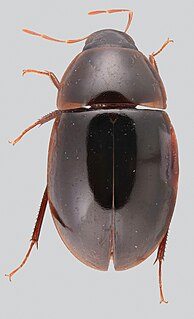
Novochares is a primarily Neotropical genus of water scavenger beetles in the family Hydrophilidae represented by 15 described species, one of which is thought to be introduced in Florida in the United States of America.














